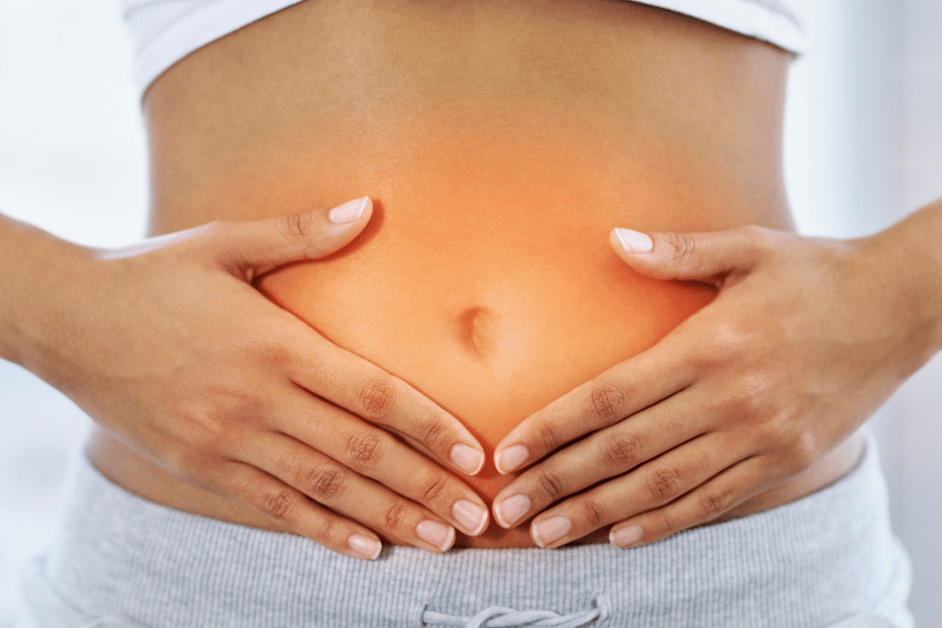Raise your hand if you struggle with menstrual cramps, painful periods, irritability, mood swings, depression, and more the days and weeks leading up to your period.
If you raised your hand, you are not alone!
Nearly 90% of all menstruating women in the United States experience premenstrual syndrome (PMS) in their lifetime. And approximately 3% of those women experience such severe symptoms that they can be categorized as having premenstrual dysphoric disorder (PMDD).
Contrary to what some people may think, PMS and PMDD are real conditions. They can cause significant physical discomfort, impact your mental and emotional health, and disrupt your daily life.
Below, we’ll review the symptoms, causes of PMS and PMDD and how to naturally treat them.
What are PMS and PMDD?
PMS is a group of symptoms that many women experience during the luteal phase of their menstrual cycle. Typically starting around ovulation and ending the first day of their period.
PMDD, on the other hand, is a type of PMS but the symptoms are much more severe. Women who suffer from PMDD experience a decreased response to the body’s inhibitory molecule, GABA, which helps to limit activity associated with stress and anxiety. Causing women to experience five or more common PMS symptoms for seven or more days.
PMS and PMDD Symptoms
PMS can begin a few days or up to two weeks before the start of a woman’s period with mild to moderate symptoms. These symptoms only occur within those two weeks and are not present during the rest of the month.
PMS can present with a variety of physical, emotional, and cognitive symptoms including:
- Bloating
- Headache
- Fatigue
- Acne flare-ups
- Breast tenderness
- Mood swings
- Depression or anxiety
- Changes in appetite
- Insomnia
- Constipation or diarrhea
PMDD shares many of the same symptoms as PMS, but these symptoms are much more severe. These symptoms can be so severe that they disrupt tasks of daily living. And, many women experience very little relief from common over-the-counter medications.
What Causes PMS and PMDD?
Scientific research hasn’t conclusively identified the cause of PMS or PMDD. Nor has it determined why some women experience it more severely than others. But, research has suggested several different theories as to what causes PMS and PMDD.
Hormonal changes that occur during the menstrual cycle:
Many believe that PMS occurs in response to the changing levels of the hormones estrogen and progesterone. Also referred to as the sex hormones.
These hormonal fluctuations are thought to increase anxiety, irritability, and other mood changes experienced before your period.
Interaction between sex hormones and neurotransmitters:
The fluctuating levels of the sex hormones can impact the brain chemicals serotonin, dopamine, and GABA. Estrogen is required to synthesize serotonin and increases the number of serotonin receptors in the brain. Whereas progesterone helps stimulate dopamine release and increase GABA function.
Because both estrogen and progesterone levels drop before your period, the production and the effect of these “feel-good” chemicals are impacted. Leading to increased anxiety, changes in mood, and insomnia.
In women who struggle with PMDD, progesterone alters the shape of their GABA receptors making it harder for GABA to bind to them and improve mood, depression, or anxiety.
Other contributing factors:
There are other contributing factors that could lead to both PMS and PMDD including:
- Genetics – There are hundreds of genes that help eliminate toxins from our bodies. One example is the COMT gene which helps to eliminate estrogen from your body. Those with the slow COMT gene mutation struggle to eliminate excess estrogen and can experience endometriosis, strong PMS, and fibroids to name a few.
- Weight – No matter the cause for being overweight, an increase in fatty tissue equals an increase in hormones. Increased production of estrogen can cause inflammatory responses in the body and promote many PMS symptoms.
- Estrogen Dominance – If the gut is not processing estrogen or the liver is unable to detox estrogen, the body will have an increased level of estrogen relative to progesterone.
- Detox Issues – If the liver is unable to detox excess estrogen it may be too stressed and require you to decrease your toxin load in other ways.
- Gut Health – Our intestines are filled with trillions of bacterial cells (known as the microbiome) that work together to regulate the production, metabolism, and detoxification of hormones. When the microbiome is disturbed and the bacteria is damaged, dysbiosis can occur. Learn more about the importance of gut health and hormones here.
- Histamine Intolerance – How your body reacts to the foods you eat can be driven by hormone fluctuations. Estrogen dominance can increase histamine and adequate progesterone can help balance it out.
Diagnosing PMS and PMDD
There is no definitive test to diagnose PMS or PMDD. However, there are several screening tools I used when diagnosing PMS and PMDD.
- Estrogen and Progesterone – DUTCH test or a serum blood test done seven days post ovulation to evaluate your estrogen and progesterone levels.
- Adrenal Testing – DUTCH test to evaluate your adrenal health and confirm you are not experiencing an HPA axis dysregulation.
- Thyroid – You need adequate amounts of thyroid hormones for your ovaries to make progesterone. Progesterone also helps the thyroid function well. Research has reported that a high percentage of women with PMS also have hypothyroidism.
- Blood Glucose and Insulin Sensitivity – High blood sugar levels lead to high insulin levels which decreases the sex hormone-binding globulin (SHBG). If your insulin is always high there won’t be much SHBG causing estrogen and testosterone to rise relative to progesterone.
Natural Treatment of PMS and PMDD
If you have PMS or PMDD, there are several natural treatments that I use to relieve symptoms. These can include strategies such as diet modifications, exercise, and supplements. All focused on improving your overall well-being, stress relief, and symptom management.
Here are some of my more commonly used natural treatments for PMS and PMDD.
Diet
Eating healthy is critical to managing PMS and PMDD. Some foods can increase the likelihood of some symptoms like bloating, blood sugar fluctuations, fatigue, and mood swings. I recommend:
- Omit refined sugar, carbs, caffeine, and alcohol.
- Choose grass-fed, wild, and organic foods when possible.
- Boost your veggie intake! Load up on cruciferous veggies and fruits high in antioxidants like broccoli, cauliflower, brussels, kale, and arugula.
- Increase your fiber during the luteal phase of your cycle.
- Add 2 TBSP of ground flaxseed to your diet daily
Exercise
Move your body daily! Several research studies have shown that moderate cardio exercise everyday can help improve PMS and PMDD symptoms in four to eight weeks!
Aim for 30 to 40 minutes per day of cardio exercise or yoga.
Supplements
Getting the required dietary supplements each day has been shown to improve PMS and PMDD symptoms. Depending upon your symptoms and dietary requirements I recommend the following supplements:
- Magnesium: Migraine headaches, anxiety, adrenal concerns, blood pressure issues…your magnesium is likely lacking. Think of it as a calming agent that you can use just about anytime.
- Vitamin B6: Helps to produce progesterone and promote GABA synthesis which can ease fatigue, irritability, and insomnia. I recommend beginning with 50 mg.
- Vitamin E and good fats. Vitamin E supplements and essential fatty acids help combat the effects of PMS by reducing the effects of the hormone prolactin. I suggest starting with 800 iu Vitamin E Tocotrienols, 2 caps of omegaMonoPure 1300 [email office for more information on this product], or 2 caps of EPO (bonus: EPO is great for glowing skin!).
- Calcium: Adding additional calcium support has shown to be a simple and effective treatment for the luteal phase symptoms of PMS. I recommend adding 1200 mg of calcium per day.
- Saffron: In women with mild to moderate depression, saffron has shown to have an antidepressant-like effect. And, it can be used throughout the luteal phase of your cycle. I used the product MoodStasis beginning with 15 mg twice a day.
- Progesterone Drops. Augmenting your progesterone with natural progesterone drops based on your labs can help mimic your body’s progesterone production. This cyclic taper allows us to taper up or down based on your personal need. (email our office for help with this product)
- Hormone-balancing herbal blends. A hormone-balancing herbal blend can help promote progesterone production and estrogen clearance. I often use Vitex, DIM, or CDG to promote progesterone production. I use Calcium d-Glutarate to help prevent estrogen metabolites from recirculating back into the bloodstream from the gut and to help eliminate excessive estrogen. And there are many classical Chinese herbal formulas specific to women’s health and hormones that I will often incorporate based on your constitution and symptom presentation.
Liver Detox
If the liver has to work hard to filter out harmful toxins from the body, its capacity to cleanse the blood from estrogen can be compromised. In addition to decreasing your overall toxic load, eliminating alcohol can help improve your liver’s ability to detox excess estrogen. Alcohol increases allopregnanolone (a neurosteroid made from progesterone) which can reduce the effectiveness of GABA. Ultimately increasing symptoms of PMS and PMDD.
Say Goodbye to PMS and PMDD Naturally
The bottom line is…if your PMS symptoms occur month after month and affect your quality of life, it’s time to get some help! You don’t need to live with physical discomfort, mood swings, anxiety, or depression.
Based on your symptoms and lab results, we will develop a personalized treatment plan to help you say goodbye to PMS and PMDD!
Are you ready to say goodbye to PMS? Begin by scheduling a free 15-minute troubleshooting call.
At the Reverse-Age Method, we believe in a holistic approach to perimenopause and beyond, that addresses the root causes of your symptoms (like insomnia, hot flashes, night sweats, erratic periods, fatigue, skin aging, weight gain, and brain fog)– to also slow the pace that your cells are aging. Whether it’s improving gut health, optimizing detox function, enhancing mitochondrial function, or building muscle mass, our comprehensive program has got you covered.
If you’re new here, be sure to check out our Blog Page for more insights and tips on how to thrive during perimenopause. Our blog is packed with practical advice, success stories, and the latest research to help you on your journey.
For more updates and community support, follow us on social media:
You May Also Like...
Insulin Sensitivity and Gut Health—A Dynamic Duo
Do you want your skin to look smooth and youthful for as long as possible? Do you want your brain to be sharp? What…
The Surprising Truth About Low Stomach Acid (And How To Solve It Naturally)
Do you burp after meals? How about get so bloated, you want to unbutton your pants? Does food feel like it just sits in…
Whether you’re looking for help with your gut, your hormones, or both, our team of practitioners work together to treat the WHOLE you – guiding you to a healthier mind, body, and spirit day by day.



